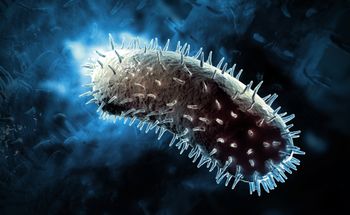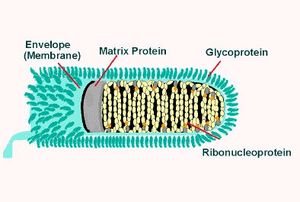Rabies Lyssavirus: Difference between revisions
m (→Introduction) |
m (→Structure) |
||
| Line 19: | Line 19: | ||
<br><b>Polymerase protein(L)</b>:<br> | <br><b>Polymerase protein(L)</b>:<br> | ||
<br><b>Matrix Protein(M)</b>:<br> | <br><b>Matrix Protein(M)</b>:<br> | ||
<br><b>Glycoprotein(G)</b>:<br> | <br><b>Glycoprotein(G)</b>:<br>forms glycoprotein spikes on the outer envelope of the virus, which allows the virus to be recognized and aid in its binding to host cells. | ||
<br>The two major components of the Rabies virus are the ribonucleoprotein complex(RNP) and the surrounding cell envelope. <br>Out of the five proteins, nucleoprotein(N), Phosphoprotein(P), and Polymerase protein(P) are associated with the RNP. The matrix protein is responsible for covering and keeping the RNP in a condensed form. The rabies virus envelope is constructed of a phospholipid bilayer with glycoprotein spikes. | <br>The two major components of the Rabies virus are the ribonucleoprotein complex(RNP) and the surrounding cell envelope. <br>Out of the five proteins, nucleoprotein(N), Phosphoprotein(P), and Polymerase protein(P) are associated with the RNP. The matrix protein is responsible for covering and keeping the RNP in a condensed form. The rabies virus envelope is constructed of a phospholipid bilayer with glycoprotein spikes. | ||
Revision as of 02:14, 8 November 2019
Introduction

Rabies Lyssavirus, commonly known as the Rabies virus, is a type of neurotropic virus that causes rabies in mammals, insects, reptiles and birds. Rabies virus is preventable for humans through vaccination or fast-acting shot that contains rabies immune globulin. If bites from rabies-infected animals did not receive immediate care and rabies symptoms start to appear in patients, it is usually fetal.
Structure
Rabies Lyssavirus belongs to the family Rhabdoviruses and the genus Lyssavirus. Rabies Lyssavirus is a bullet-shaped RNA virus that contains one copy of a enveloped single-stranded non-coding RNA genome. Rabies Lyssavirus genome encodes five essential structural proteins:

Nucleoprotein(N):
The nucleoprotein encapsidates the non-coding RNA genome to form the viral ribonucleoprotein complex (RNP). The resulting RNP is responsible for the protection of rabies virus genome from RNA degradation cause by ribonuclease. Other than genome protection, nucleoprotein is also a antigens for viruses due to their group and strain-specific antigenic determinants.
Phosphoprotein(P):
Polymerase protein(L):
Matrix Protein(M):
Glycoprotein(G):
forms glycoprotein spikes on the outer envelope of the virus, which allows the virus to be recognized and aid in its binding to host cells.
The two major components of the Rabies virus are the ribonucleoprotein complex(RNP) and the surrounding cell envelope.
Out of the five proteins, nucleoprotein(N), Phosphoprotein(P), and Polymerase protein(P) are associated with the RNP. The matrix protein is responsible for covering and keeping the RNP in a condensed form. The rabies virus envelope is constructed of a phospholipid bilayer with glycoprotein spikes.
Genetics
Include some current research, with a second image.
Evolution
Research, image.
Vaccination

Research, pre and post vaccination, image
Case Studies
Jeanna Giese and California girl 2009, similar Milwaukee treatment. Image
Research
Research directions: permeability of the blood-brain barrier, central nervous system. Rabies virus outer shell, which is unable to cause disease, can be used in other medical field.
Conclusion
Overall text length should be at least 1,000 words (before counting references), with at least 2 images. Include at least 5 references under Reference section.
References
Edited by Yangyang Liu, student of Joan Slonczewski for BIOL 116 Information in Living Systems, 2019, Kenyon College.
